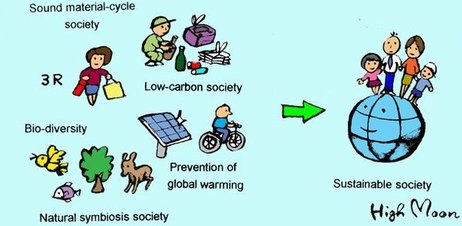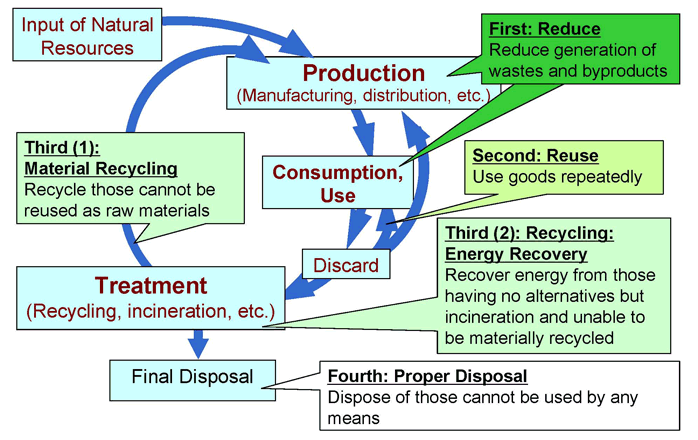The 3R Concept and Waste Minimization
|

Abstract
The 3R concept (reduce, reuse, and recycle) has become a cornerstone of sustainable production and consumption by promoting resource efficiency and waste minimization throughout the entire lifecycle of products and services. This concept is exemplified by national initiatives in countries such as Japan, Canada, Germany, and the USA, which have implemented effective policies to reduce environmental impacts through recycling, reuse, and waste recovery.
Central to Japan's approach is the creation of a 'Sound Material Cycle Society', underpinned by laws, policy instruments, stakeholder engagement, and monitoring frameworks such as Material Flow Accounts. The success of such initiatives depends on integrated action across governance, education, technology, and finance, supported by life-cycle-based strategies targeting production, consumption, and disposal. Future directions emphasize systemic integration through investment, production, distribution, and consumption policies that encourage sustainable behavior and institutional practices.
Keywords
3R, waste minimization, resource efficiency, recycling policy, Sound Material Cycle Society, sustainable production, material flow accounts, life cycle approach
|
 |
Hari Srinivas |
|
Concept Note Series C-076. June 2015.
|
The popular and well-known concept of "3R" refers to reduce, reuse and recycle, particularly in the context of production and consumption. It calls for an increase in the ratio of recyclable materials, further reusing of raw materials and manufacturing wastes, and overall reduction in resources and energy used.
These ideas are applied to the entire lifecycles of products and services - from design and extraction of raw materials to transport, manufacture, use, dismantling/reuse and disposal. Some achievements and examples of the 3R concept and waste minimization:
- Recycling (Japan): The glass cullet use rate has been increasing every year since FY1990 and had already reached 90.3% by FY2003, exceeding the 85%-level that was expected to be achieved by FY2005 under the Law for Promotion of Effective Utilization of Resources.
- Reuse (Canada): Mandatory provisions of used oil deposit/collection facilities by all vendors of lubricants to target used oil produced by different users, has enabled the return of used oil to the point of purchase for reuse or recovery.
- Minimization and Recovery (Germany): Ordinance on the Avoidance and Recovery of Packaging Waste, 1998, calls for avoidance or reducing the environmental impacts of waste arising from packaging. By June 2001, the share of all packaging waste being recovered was 65 percent by weight, and the share of recycling was 45 percent by weight.
- Recycling and Composting (USA): In 1999, recycling and composting activities prevented about 64 million tons of material from ending up in landfills and incinerators. USA recycles 28 percent of its waste, a rate that has almost doubled during the past 15 years. 42 percent of paper, 40 percent of plastic soft drink bottles, 55 percent of aluminum beer and soft drink cans, 57 percent of steel packaging, and 52 percent of major appliances are now recycled.
Japan's 3R Initiative towards a 'Sound Material Cycle Society'
Japan's impetus for developing a 'Sound Material Flow Society' is derived from three interrelated causes - [1] the shear volume of wastes being generated, [2] rapid industrial development, and [3] the limitations placed by Japan's small land mass. This law, and its constituent individual laws and plans, lie at the core of Japan's 3R Initiative.
 The Concept of a Sound Material Cycle Society
The Concept of a Sound Material Cycle Society
(Source: Ministry of Environment, Japan)
A 'Sound Material Cycle Society' is defined as a society in which the consumption of natural resources is minimized and the environmental load is reduced as much as possible. The basic principles of the Initiative call for "the realization of a society in which sustainable development is possible with less environmental impact; prioritization of handling products, wastes and recyclables; and ensuring appropriate material cycle in nature."
The Initiative has enabled the refocus of existing environmental laws on material flows, and enact new ones to fill gaps in existing laws. The basic structure is outlined in the "Fundamental Law for establishing a Sound Material Cycle Society", and in two general laws on waste management and recycling - "Waste Management and Public Cleansing Law" and "Law for the Promotion of Utilization of Recyclable Resources". The rest of the package of six laws relate to specific issues such as containers and packaging, household appliances, construction materials, food, vehicles etc., including green purchasing.
Awareness raising among the general public, as well as the private sector has been strongly built into the initiative, in order to facilitate broader and deeper participation, particularly at the local level. Political leadership and strong commitment has also been mobilized to drive the initiative forward - from the prime minister and the national government ministries, down to prefectural governors and city/town mayors. The traditional collaborative relationships between industry on one hand and research institutions/universities on the other, have been further mobilized for Initiative.
Several 'Centers of Excellence' have been set up to research on themes drawn from the Initiative. The Initiative places rightful emphasis on monitoring and evaluation. It outlines the kinds of indicators to be used and targets to be achieved. The key driver in the Initiative is 'Material Flow Accounts (MFA)' which looks into resource productivity (inputs), cyclical use rate (throughputs) and final disposal amount (outputs)
Direction of Future Work
The success of a '3R' initiative will largely depend on the right mix of policies and programmes implemented at the local level. As the Japanese experience has shown, the key spheres of action will revolve around governance issues such as laws, legislation, rules and procedures; education and awareness building issues, targeting stakeholders in the public and private sectors, but also communities and consumers alike; technology issues, to ensure that industrial, manufacturing and market activities and technologies used have a minimum impact on the environment, and produce the least amount of wastes possible; and financial issues, focusing on subsidies and taxation to facilitate action in the right direction, and to discourage unsound practices.
Ultimately, the life cycle of a product in itself should guide the action necessary to development and implement a comprehensive 3R Initiative based on integrated waste management systems:
- At the production stage, the target stakeholder of businesses should look at 3R oriented designs for resource-saving, long-life; reuse; recycling; and labeling materials used.
- Orienting the consumption/use stage of the life cycle a product can be focused on national and local authorities to take the lead in purchasing environmentally friendly products and services.
- The collection/recycling stage is critical, asking of consumers to properly discharge the products they use, or participate in product buy-back programmes; and of businesses to promote product recycling.
- At the final stage of disposal, businesses and municipalities have the responsibility to ensure that waste products are properly discharged and/or incinerated.
Much of this will also depend on developing an integrated framework bringing together the above points with other issues, including (a) Investment policies and practices, such as greener procurement, subsidies and eco-taxes, Socially Responsible Investment (SRI) etc.; (b) Production policies and practices, such as integrated product policy, life cycle assessment, extended producer responsibility, precautionary principle, polluter pays principle, eco-efficiency/ clean production, health and safety standards etc.; (c) Distribution policies and practices, such as right to know, advertising reform, eco-labeling, packaging, pricing, transportation etc.; and (d) Consumption policies and practices, such as consumer values, norms and behaviour, and awareness and education.
|


